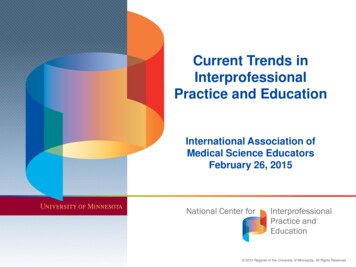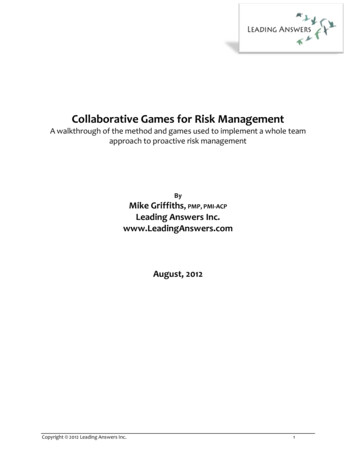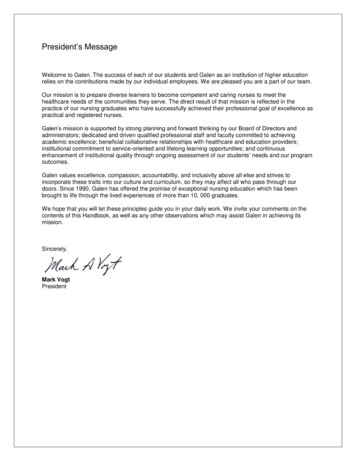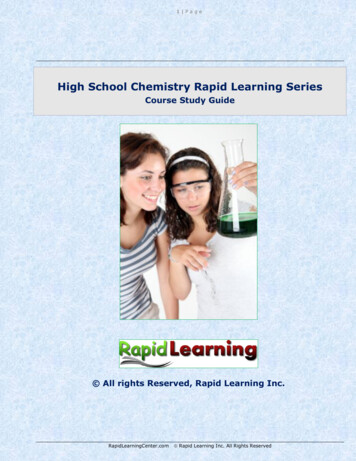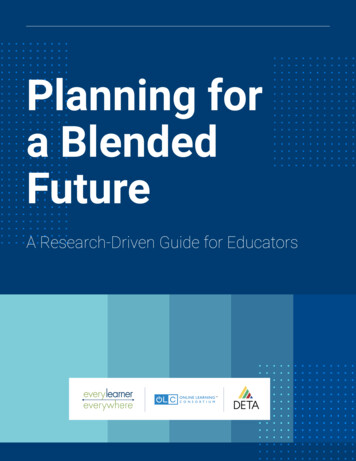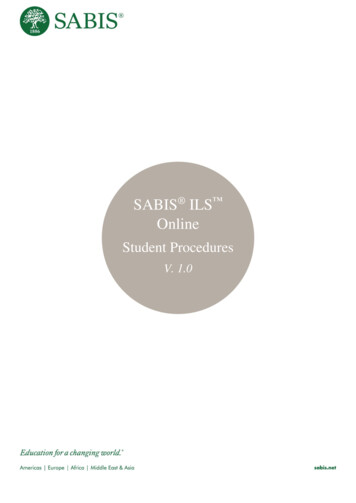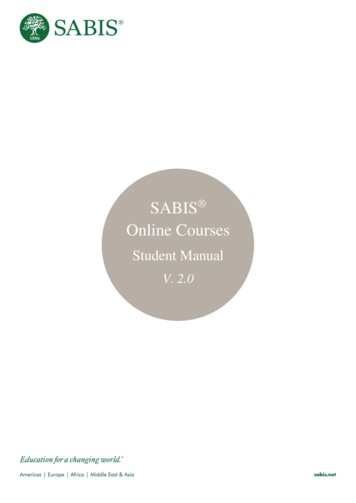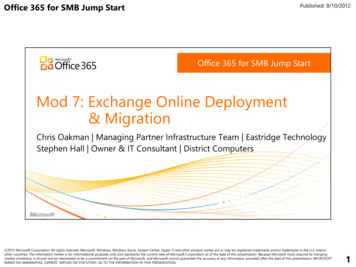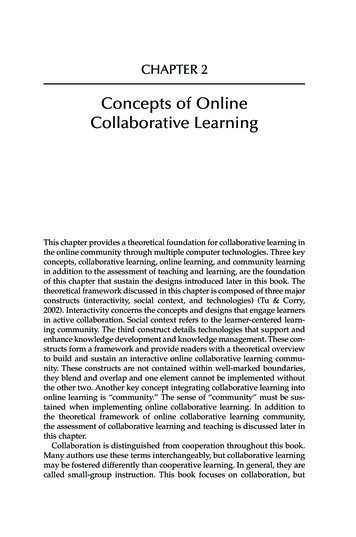
Transcription
CHAPTER 2Concepts of OnlineCollaborative LearningThis chapter provides a theoretical foundation for collaborative learning inthe online community through multiple computer technologies. Three keyconcepts, collaborative learning, online learning, and community learningin addition to the assessment of teaching and learning, are the foundationof this chapter that sustain the designs introduced later in this book. Thetheoretical framework discussed in this chapter is composed of three majorconstructs (interactivity, social context, and technologies) (Tu & Corry,2002). Interactivity concerns the concepts and designs that engage learnersin active collaboration. Social context refers to the learner-centered learning community. The third construct details technologies that support andenhance knowledge development and knowledge management. These constructs form a framework and provide readers with a theoretical overviewto build and sustain an interactive online collaborative learning community. These constructs are not contained within well-marked boundaries,they blend and overlap and one element cannot be implemented withoutthe other two. Another key concept integrating collaborative learning intoonline learning is “community.” The sense of “community” must be sustained when implementing online collaborative learning. In addition tothe theoretical framework of online collaborative learning community,the assessment of collaborative learning and teaching is discussed later inthis chapter.Collaboration is distinguished from cooperation throughout this book.Many authors use these terms interchangeably, but collaborative learningmay be fostered differently than cooperative learning. In general, they arecalled small-group instruction. This book focuses on collaboration, but
12Online Collaborative Learning Communitiesmany of the theoretical constructs, strategies, and guidelines can be appliedto cooperation. It is necessary for readers to grasp the characteristics of bothconcepts. In practice, most educators apply a mixture of both strategies totheir instruction.Here are the main points distinguishing collaboration and cooperation:Collaboration Applies small-group activities as strategies to develop higher-order thinkingskills and enhance individual abilities to master knowledge Encourages the laissez-faire approach for higher-level, less-foundationalknowledge content Assumes that knowledge is socially constructed Is applied in collegesCooperation Encourages an explorer approach but in a more structured manner for the foundational knowledge typified in gateway instruction Assumes knowledge that is socially constructed but is the methodology ofchoice for foundational knowledge Is applied in primary schoolINTERACTIVITYInteractivity includes collaboration and active learning. Collaborationdoes not occur unless learners are granted authority over and are activelyengaged in their learning activities.CollaborationCollaborative learning uses small groups of learners in the instructionencouraging them to maximize their own learning and each other’s learning. Collaborative learning engages learners in knowledge sharing,inspiring each other, depending upon each other, and applying activesocial interaction in a small group. Therefore, collaborative learningdepends upon the art of social interaction among learners rather than amechanical process. “Collaborative learning is a personal philosophy, notjust a classroom technique. In all situations where people come togetherin groups, it suggests a way of dealing with people, which respects andhighlights individual group members’ abilities and contributions. Thereis a sharing of authority and acceptance of responsibility among groupmembers for the group’s actions” (Panitz, 1996). Instructors shift theirauthority, under the auspices of ideal collaborative learning, to the learners and provide the foundation and learning structures to guide them
Concepts of Online Collaborative Learning13through various learning processes and experiences and through activesocial interaction on substantive issues by applying modern technology.“Good learning, like good work, is collaborative and social, not competitive and isolated. Sharing one’s ideas and responding to others’ improvesthinking and deepens understanding” (Gerdy, 1998).Merely corralling learners into groups does not assure ideal collaborative learning. Four important issues must be considered when integratingonline collaboration into instruction: empowering learners, building communities, continuing support, and being patient. Regardless of how collaborative learning is implemented, these four important issues must not beneglected.Empowering learnersInstructors must empower learners in any online learning environment(Dickstein, 1998). Learners should be accountable for their learning anddetermine what, how, when, and where to learn. Therefore, instructorsbecome facilitators to guide learners through different learning processes,permitting a variety of elements to accommodate different learning stylesrather than attempting to force everyone into the same learning pattern.Some structure is necessary, but care must be exercised to prevent it frombecoming too rigid, for example, a step-by-step instruction. Empoweringlearners is a difficult task for instructors because they must risk passingauthority to their learners.Building communitiesHumans learn through rich social interaction in a community (Tu &Corry, 2002). Learners must associate and connect internally in the classroom and externally with other learners and instructors. This allows thereview of multiple perspectives and enriches the learning experiences(Honebein, 1996).Continuing supportThe process of collaborative learning must be constantly reinforced. Theobjectives of collaborative learning must be explained in detail to ensurethat learners understand it clearly. Providing seamless intellectual, technical, social, mental, and emotional support throughout the entire learningprocess allows learners to demonstrate their independence. Frequently,learners embark upon a course of study with the simple expectation ofa good grade; but they evolve into learning independently when theyunderstand the process and have appropriate support. The absenceof adequate support is a major failure. Time-consuming? Yes, it is atime-consuming process that engages learners in an enriched learningexperience.
14Online Collaborative Learning CommunitiesBeing patientSocial interaction takes longer to develop in a technology-based environment (Walther & Burgoon, 1992), particularly a collaborative learningenvironment. Learners must be allowed enough time to build a socialfoundation and to finish their tasks. The rudiments of a communityrequire more time to develop in online social environments than in faceto-face social environments (Tu & McIsaac, 2002); therefore, short-termonline collaboration is inadequate to support the development of a community and is totally inadequate to foster community dynamics.Active LearningThe second important construct in interactivity is active learning.Because of the blurred roles between students and teachers, more weightis placed on the learning process/experience than upon roles and “teaching” processes. Both students and teachers are learners and share theirresponsibilities in an online community and should be allowed a voicein determining what learning experiences they would like to receive.Collaborative online interaction is best developed with maximumautonomy, without excessive teacher intervention and control, allowinglearners to find their voices with a democratic, student-driven learningenvironment. Morrison (1995) suggested that the learning process isunbounded by time (when one learns), space (where one learns), mode (howone learns), pace (the rate at which one learns), level (the depth of learning), and role (with whom one learns). These conditions can be applied toonline collaborative learning. Therefore, a collaborative learning community is not merely learner-centered; it is a learner-driven process whenlearners are granted these five conditions.Several effective designs are introduced later in this book dealing withthe interactivity dimension. Please see Chapters 4 and 5 for Design 3, PeerSupport Assignment; Design 4, Interactive Project Presentation; Design 5,Online Moderation; and Design 6, Online Debate, for the design instruction and strategies.SOCIAL CONTEXTThe second construct, social context, emphasizes the characteristics ofthe learner and the learner-centered social learning environment (learningcommunity). Collaboration is inherently social (Golub, 1988; Ocker &Yaverbaum, 1999). A social group holds values regarding one’s obligationsto others. “Hence, people help others and/or their group because they feelit is the morally appropriate action” (Kramer & Tyler, 1996). These processes are related to the personal characteristics of online learners. Lathamand Locke (1991) found that a group member skilled in self-management,
Concepts of Online Collaborative Learning15goal setting, self-monitoring, and self-assessment was critical for performance. Group members in a successful group were committed to thegroup’s mission and norms, could be counted on to perform their respective tasks, and enjoyed working in a group (Snow, Snell, & Davison, 1996).Successful online collaborative learning is an online learning community,which is an organization where community members engage intellectually, mentally, social-culturally, and interactively in various structured andunstructured activities to achieve their common learning goals on electronic communication technologies. Learners learn together and the community, itself, learns as well (Schlager, Fusco, & Schank, 2000).Learner-CenteredLearner-centered issues are independence (the opportunity to makechoices), competence (ability and skills), and support (both human andmaterial) (Baynton, 1992). Learner-centered education has been mistakenly thought to mean leaving online learners alone, passing all responsibilities to them, and denying them appropriate communication. Onlinelearners demonstrate higher levels of independence in learning; buttheir competence and technological expertise should be considered andappropriate support provided to assure a richer learning environment.Inadequate analysis of these three components may result in online learners failing and dropping out of the online instruction.Are students ready to be accountable for their own education through collaborative learning? The fact is that many of them are not ready (Tu, 2003).How often have we heard “Can I do a personal project instead of teamproject?” “It is unfair on grading.” “It always ends up certain people (students) are doing the work for the entire team.” Or “I want to earn an A fromthis class and I don’t want to let someone affect my class grade.” Whenlearners ask these questions or make disparaging comments, it reveals thatthey do not see the value of collaborative learning, underscoring the necessity of explaining its purpose and its values at the beginning of the course.In collaborative learning environments the teachers are learners as well.Are teachers ready for collaborative learning? Perhaps not many teacherswill say yes. Most teachers may see the value of collaborative learning butthey are reluctant to collaborate with other teachers, scholars, and contentexperts because of a fear of failure, the time involved, or being unfamiliarwith online collaborative learning instructional designs.CommunityThe broader view of “community” has been defined as a place wherepeople conduct community activities, share common beliefs, and share ameans of communicating (Brooks, 1997). Gilbert (2002) stated that education
16Online Collaborative Learning Communitiesat Massachusetts Institute of Technology (MIT) requires a combination ofthe content in conjunction with a faculty member and, the critical element,the learners, mixed together in an environment that provokes inquiry andprovides useful facilities to support knowledge development. This reflectsthe importance of learning communities.When learning activities and interactions occur electronically, theresulting environment is referred to as an online learning community.Researchers are now advancing toward the definition of a community thatlearns, retains, and evolves knowledge (Tu & McIsaac, 2001). How learners gather and apply appropriate information to knowledge constructionis more critical than simply obtaining information; thus, examining knowledge construction in an online community and advancing it to the levelof a community that learns, rather than a location where information issimply shared and individuals learn together.A “learning community” is decidedly different from “community learning.” Several researchers (Schlager et al., 2000; Tu & McIsaac, 2001) agreewith this argument (Graham, 1997). A learning community is seen as acommunity for participants to learn together where learning is gained horizontally. In comparison, in community learning, learning is gained bothhorizontally and vertically. Community members learn and the communityitself also learns. Both types of learning are critical because communitygrowth and development and the learning of community members enhance each other. Therefore, the model that stretches learning from a schoollearning community to lifelong learning is a good example of the relationship between the learning community and community learning.Full community integration should advance beyond just a team community. It is difficult to draw a boundary between communities. Teammembers learn from various communities. With advanced technologies,team members are exposed to a greater number of related communitiesthat provide richer perspectives for learning. The course itself is a community. With appropriate design, learners can expand their communitiesacross courses, programs, schools, districts, regions, and countries.Trust is one of most important factors in social context. Trust influencesinterpersonal relationships in social interaction (Bruffee, 1995; Tu, 2002).Different forms of trust have been defined: affective, cognitive, behavioral,or “integrated” (Cummings & Bromiley, 1996; Mayer, Davis, & Schoorman,1995; McAllister, 1995). One accepted definition of trust is: “the willingnessof a party to be vulnerable to the actions of another party based on theexpectation that the other will perform a particular action important to thetrustor, irrespective of the ability to monitor or control that other party”(Mayer et al., 1995, p. 712). Jarvenpaa, Knoll, and Leidner (1998) stated thattrust is based on the expectation that others will behave as expected; therefore, trust is a type of perception.
Concepts of Online Collaborative Learning17Community of Practice (CoP)Communities of practice (CoPs) are groups of people who share similargoals, interests, and practices and, in doing so, employ common practices,work with the same tools, and express themselves in a common language.Through such common activity, they come to hold similar beliefs andvalue systems (Collaborative Visualization (CoVis) Project, 2000). Theseprofessionals are informally bound to one another through exposure to acommon class of problems, a common pursuit of solutions, and, as a community, embody a store of knowledge (Peter Trudy Johnson-Lenz, 2000).A common sense of purpose and a real need to acquire the knowledge ofeach other holds these professionals together. Members of CoP collaborate directly, use one another as sounding boards, and teach each other.They are not merely peers exchanging ideas who share and benefit fromeach other’s expertise, but members committed to jointly develop betterpractices for the organization. Thus, developing a “community thatlearns” is as critical as developing a “community of learners.”Knowledge sharing is a process to guide someone through our thinkingor use our insights to assist them in seeing their own situation better.Communities of practice (CoPs), one of the knowledge-sharing concepts,enables the employees to be conducive to mastery of new knowledge(Lieberman, 1996) in organizational learning and has become a cornerstone of the knowledge strategy of leading organizations (McMaster,1999; Renyi, 1996). Several successful reform projects applied to learningorganizations have supported this concept (National Science Foundation,1997; Stokes, Sato, McLaughlin, & Talbert, 1997). Although CoP is not anew concept, we have little experience in how to foster this type oforganic organizational learning community, particularly integrating electronic communication into CoP building. In fact, Sharp (1997) suggestedthat improved learning would often come from encouraging development both of CoPs and CMC communities of discourse.Electronic media are pervasively applied to employees’ daily work.With the popularity of e-learning in the workplace, employees are able tolearn anywhere and anytime to advance their work-related knowledgeand skills. Applying e-learning empowers CoPs to extend beyond thelocal environment and become global. Yet understanding how theselargely informal, voluntary, and self-organizing communities actuallywork via electronic media presents a challenge for organizations. Withoutan understanding of their dynamics and composition, community initiatives can be wasteful, ineffective, or even harmful.Two relevant theoretical frameworks, McDermott’s (2000) Four KeyChallenges of CoP and Tu and Corry’s E-Learning Community (2002),address important issues in designing e-CoP.
18Online Collaborative Learning CommunitiesFour Key Challenges of CoPMcDermott (2000) proposes four key challenges in building, sustaining,and enabling CoPs to conduct effective knowledge sharing. The four keychallenges are the Management Challenge, the Community Challenge,the Technical Challenge, and the Personal Challenge. The ManagementChallenge describes the structures and organizations necessary to guideand lead knowledge generation, sharing, and retention. The CommunityChallenge is the creation of real values for the community that bonds themembers and coherently sustains the life of communities. The TechnologyChallenge is the design of knowledge management systems that ensureeffective information exchange, capture, and retention in a reusable formand to reflect upon and stimulate complicated human thinking. Finally,the Personal Challenge focuses on the relationships between/amongcommunity members. These four keys should be nurtured, cared for, andlegitimized to ensure that support systems are not too strenuous for thecommunity to lose appeal for the members and not too little to allow thecommunity to wither.E-Learning CommunityTu and Corry (2002) propose “Instruction,” “Social Interaction,” and“Technology” as three major dimensions for e-learning communities. Todevelop an ideal e-learning community, the three dimensions should beconsistently maximized. Piecemeal development may alter learning experiences. However, balanced development is a dynamic force. The development of e-learning communities may focus on different dimensions atdifferent times, situations, and opportunities. The community may startwith a greater focus on social interaction and technology. Once the community is formed, instruction can be integrated to facilitate communications. As the community develops, its influence increases and expandsoutward. This theoretical framework for e-learning communities isdynamic, not static; flexible, not fixed; and negotiable, not pre-set.The effective designs to support this dimension can be found in Chapters6, 7, and 9 and Design 7, Virtual Experts, Design 8, Guest Moderators,Design 9, Building CoP, Design 10, Electronic Media for CoP, Design15, Understanding Social Context, and Design 16, Optimizing OnlineInteractivity.TECHNOLOGIESTechnologies function as major tools in human learning. Electroniccomputing and telecommunications are converging into human communication and knowledge development technologies. Technology notonly delivers content (information), but it has the capability to stimulate
Concepts of Online Collaborative Learning19opportunities for knowledge development. Many people prefer computertechnology communication tools, such as computer-mediated communication (CMC), to face-to-face communication. Technologies, such as e-mail,threaded discussion board , listserv, and real-time discussion, are powerful tools for human communication and to bring people together. Thisis true in education communication as well. In fact, contents, bits, learning, and cognitive science are converging into “knowledge media”(Eisenstadt, 1995). Cooper and Robinson (1998) identified technology asthe most important issue in small-group learning. The technology-basedinstruction may have a profound impact on student outcomes. Simplymaking technologies available for learners is not enough for nontraditional learners in the online collaborative learning process (Ocker &Yaverbaum, 1999; Tu & Corry, 2002). Therefore, appropriate technicaldesigns of computing technologies become critical. CMC and knowledgemanagement systems are discussed here to address how technologiesshould be applied to online collaborative learning.Computer-Mediated Communication (CMC)Keegan (1993) declares, “Without a medium of communication the concept ‘distance education’ would not be an educational process. . . . Bothsynchronous and asynchronous media are viable means of communication for distance education . . . [and] allow two-way communication”(p. 118). Discussing quality and access in online learning from theoreticalconstructs, Garrison (1993) states that the “concern for quality in distanceeducation has identified an emerging paradigm based upon two-waycommunication as a necessary and central component of an educationaltransaction” (p. 17). In other words, interactive two-way communicationis the critical component in online learning. CMC has been considered oneof the most effective media for online learning.CMC technologies can be classified as synchronous (real-time communication) or asynchronous (time-delayed communication) systems(Gunawardena & McIsaac, 2003; Walther & Burgoon, 1992). Asynchronouscommunication does not require participants to be communicating at thesame time or in the same place, for example, electronic mail, electronicthreaded discussion boards, and listservs. Synchronous communicationrequires participants to communicate at the same time, that is, real-timecomputer conferencing.A recent analysis (Tu, 2000) reveals that CMC systems enhance andinhibit online interaction. The user’s perceptions and the attributes ofCMC must both be taken into consideration (Gunawardena, 1995)because each of them has different attributes, which may impact onlinelearning differently (Tu, 2002). The successful use of CMC in the classroom requires the selection of the correct CMC medium. CMC does not
20Online Collaborative Learning Communitiesreplace face-to-face communication; however, CMC provides a more flexible delivery and a greater selection of communication channels for onlinelearners.CMC technologies should be examined extensively. Sharing thinkingpatterns and using these patterns among virtual learning communitiesshould be a central practice. Valuable information about past projecthistory generated by an individual is not captured, retained, or maintained in a useable format to enrich the community (Tu & McIsaac, 2001).Therefore, if an individual leaves the community, the community returnsto where it started and considerable time and resources may be requiredto reconstruct the lost knowledge or expertise. Weiser and Morrison(1998) pointed out the importance of retaining knowledge, a concept thatwas emphasized almost 60 years ago by Bush (1945). The ability to capture thinking trails is crucial in future thinking devices so that individuals and groups can trace the ramifications of the thought processes andlearn from it by examining their own thinking. This would lead us to thedevelopment of techniques of electronic knowledge management.Knowledge ManagementAn additional advantage of communication technology is its ability tobe used as an extension of human knowledge. Knowledge cannot be created from emptiness. The foundation of current human knowledge is previous knowledge and maintaining knowledge for re-use is a critical issuein online learning. Therefore, a tool that is able to assist in the preservation and extension of human knowledge is important.When using knowledge construction technologies, one should movebeyond a forum for exchanging tidbits and opinions to structures thatreadily capture knowledge-value and foster rapid accumulation andgrowth of a community’s capabilities (Schlager et al., 2000). For example,a technology should have the capacity to capture and index knowledgeconstruction processes and patterns and allow users to retrieve andmanipulate information from the knowledge data bank. In that manner,an online community can lead to the development of personalized, selfadaptive learning systems. In an ideal online community the contributions that are made by one member should be readily located andretrieved by other members. The processes involved in contributingknowledge and locating and retrieving it are keys to knowledge miningand knowledge construction. Knowledge becomes an emergent propertythat transcends the fixed-size-and-space concepts of media and information. It transcends the notion that one can impart knowledge to learnersby filling them up from the teacher’s vessel.Effective knowledge management can lead to significant improvementsin learner performance. A community that can effectively manage its
Concepts of Online Collaborative Learning21knowledge assets is able to treat the knowledge component of learningactivities as an explicit concern of learning reflected in strategy, policy,and practice at all levels of the learning environment. Tu and Corry(2002) proposed five steps to implement a knowledge management solution: (a) identify the essential elements of knowledge management; (b)assess infrastructure by evaluating network, computer systems, security,and information; (c) anticipate the new roles of the knowledge officer,managers, or administrators, and their responsibilities; (d) select the righttools, technologies, and partners to ensure scalability and usability, and(e) support and adopt realistic collaboration. Tu and McIsaac (2001) stressthe importance of knowledge management tools for online learning, making a direct connection between both explicit (recorded) and tacit (personal know-how) intellectual assets. In practice, knowledge managementoften encompasses identifying and mapping intellectual assets within thelearning environment, generating new knowledge for competitive advantage within the learning environment, making vast amounts of information accessible, sharing the best practices, and implementing technologiesthat enable all of the above, including groupware, database, intranets, etc.Discovering the important factors that have an impact on the knowledgeconstruction process should occur in future research. In addition, theselection and use of appropriate technologies to support the process isalso critical.Chapter 8, Technology, includes three designs that will provide moredetails in appropriate applications of technologies. These designs areDesign 12, Communication Technology; Design 13, Collaboration Tools;and Design 14, Selecting Appropriate Online Communication.ASSESSMENT IN COLLABORATIONOnline collaborative learning is an effective instructional design toenhance learning and training. The issue of how to evaluate online collaborative learning has been critical and challenging. Many researchersand practitioners have not reached an agreement on effective ways toassess learners’ educational gains in the collaborative learning process,particularly in an online environment. Which assessment is more appropriate for collaborative learning, a group grade or an individual grade?Traditionally, instructors apply summative evaluation methods to assessthe end-product and provide one grade for all team members. When ateam grade is applied, learners opine that some team members contributemore to the team’s work than others and a single team grade is unfair. Wehave all heard learners comment that doing collaborative projects isunfair because some participants fail to be involved in team activities.Additionally, instructors are usually not participants in the collaborativeprocesses of learners; therefore, it is difficult for them to determine a fair
22Online Collaborative Learning Communitiesgrade. The learning process is critical to collaborative learning. Online collaborative learning, unlike cooperative learning, puts more weight on theteam process in addition to the end-product. If individual grades areapplied, it is difficult for instructors to assess the collaborative processsince instructors are not part of the process.Current Weaknesses in Instructor EvaluationWeaknesses exist in the traditional instructor evaluation methods foronline collaborative learning. Traditionally, instructors have determinedthe evaluation by an appraisal of the end-products of collaborative projects and one grade is given to all team members. This method of evaluation results in concerns that must be addressed, namely: fairness ofevaluation; end-product driven; teacher-centered; inability to improvecollaborative skills; and less active collaboration.Fairness of EvaluationCommonly, one grade is assigned to all of the team members in anonline collaborative learning setting. Learners often conceive that onegrade applied to all team members is unfair because some memberscontribute more than others. It is challenging for the instructors to befair in evaluating each indi
learners embark upon a course of study with the simple expectation of a good grade; but they evolve into learning independently when they understand the process and have appropriate support. The absence of adequate support is a major failure. Time-consuming? Yes, it is a time-consuming

